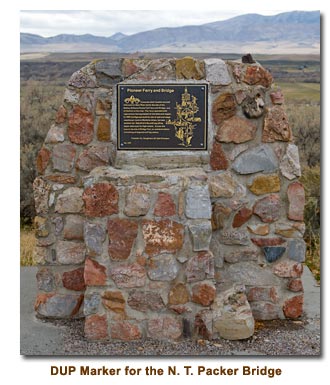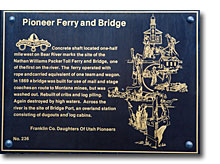Weston, Idaho 1865
Weston, the first settlement in Cache Valley on the west side of Bear River, was first settled in the year of 1865 by fifteen families, namely—
| Weston Settlers | ||
|---|---|---|
| Christopher Funk | Samuel Rogers | Anton Jensen |
| Hans Funk | Carl Nelson | J. C. Jensen |
| Wilson Robbins | Hans Kofoad | J. C. Nelson |
| Nels Georgesen | Soren Hansen | John Maughan |
| Warner Hoopes | Rasmus Nelson | Mathew Fifield |
This small group of pioneers was attracted to the west side of Cache Valley by the prospect of good crops as the soil was very good and the stream of water running through the meadows inspired them as home seekers to venture upon permanent settlement. The beautiful canyon to the northwest, with the high mountains in the background was an inspiration to the pioneers who were a nature-loving people.
At that time the part of the land which looked best to them was the meadow surrounding Weston Creek, now known as Cedarville, and they settled on the north side of the creek about three miles west of the present location of the town of Weston.
The above named band of pioneers arrived at Weston on the fifteenth on April in the year 1865, having crossed Bear River on the ice. They at once went to work building homes and preparing for crops.
The homes were mostly “dugouts,” with a few logs for supports and dirt roofs. The corps raised the first were destroyed by crickets; consequently the settlers were in finical distress. However, in spite of hardships and threatening starvation, they continued to farm the land. In the year 1866 a fair crop was planted but during the early summer the Indians drove the settlers off the land and made so much trouble for them they had to vacate and move to the east side of the Valley where several settlements had been established. Some of them came back to their old homes in the fall of the year and harvested the crop which was left, and then returned to the east side of the Valley for the winter. The Indians were so fierce that none of the settlers ventured to winter on the farms.
Before they were driven off, the settlers had organized a ward and Mr. Christoffer Funk had been appointed Bishop over them. Thus he became the first bishop of Weston.
In the spring of 1867 they again returned to Weston and having explored the land now known as the south fields, decided to change the townsite to this place, settling the present town of Weston. They considered this place more centrally located as it would give them a better opportunity to farm the two fields, namely, the fields along the Weston Creek in the Cedarville district, as well as the south fields along the west side of Bear River. From this time on, a more permanent settlement was established.
Very difficult circumstances, however, befell the people. The crops for several years were destroyed by crickets and grasshoppers and the Indians were a great menace to the settlers. Nevertheless, being of the stern quality which our early pioneer elsewhere displayed, they stuck to it and made progress as best they might.
At this new location, Elder John Maughan was appointed as acting bishop and had charge of the distribution of land which was allotted in small tracts to each of the settlers.
The first schoolhouse was a log cabin built by Bishop John Maughan in the year 1867, and owned by him. The first schoolteacher at this place was Mr. William Dees. The enrollment numbered five pupils.
 The pioneers were very busy making roads and bridges and improving their surroundings. The first bridge across Bear River was built in the year 1868, about a mile and a half northeast of the Frue Hill, and was known as the Packer Bridge.
The pioneers were very busy making roads and bridges and improving their surroundings. The first bridge across Bear River was built in the year 1868, about a mile and a half northeast of the Frue Hill, and was known as the Packer Bridge.
The first Wagon road was built from Weston to the Packard Bridge and over the Franklin Meadows to the town of Franklin.
The first schoolhouse was located on what is now known as Peter Mickelsen’s corner, on the southeast corner of block two, in the present town site of Weston.
During the year 1868, a meeting house was erected on the public square, where the present amusement hall is now standing. As soon as it was completed it was used not only for the religious services under the leadership of Bishop John Maughan, but also as schoolhouse and amusement hall for several years thereafter. The meeting house was built of logs hauled from what is now known as the Clifton Basin. The people were living in small log houses and “dugouts,” or dirt cellars.
A man by the name of James Mack built the first flourmill on the Weston Creek south of the present location of the town of Weston, in the year 1867. His father was the first miller. The mill was of stone and the grist was ground between two hewed stones the lower one being solid while the top stone turned around on top of the lower on and in this manner ground the wheat, corn or other grain suitable for human food.
 The first Sunday school was organized in the year 1867 with Mr. Soren Jensen as superintendent.
The first Sunday school was organized in the year 1867 with Mr. Soren Jensen as superintendent.
All the land was first settled on what is known as “Squatters” right, on small tracts meted out to the settlers by the bishop or the presiding elder. In the early seventies, the people commenced taking up land under the homestead act.
Water for all purposes was diverted from the Weston Creek, in small ditches. The first ditch was taken out in 1865 for irrigation purposes. The same ditch is still in existence although changed and enlarged. It is today known as Ditch Number One. The first reservoir for storing water for irrigation purposes, was built in the early eighteen-eighties.
The first business building in Weston was a log room owned by Bishop John Maughan and was under the same roof as his dwelling. The merchants were John Maughan, Wilson Robbins. The first blacksmith shop was owned and operated by Mr. Ferdinand Fredrickson, who also was the village fiddler for many years. He was a very industrious man and a dear friend of all the young people who when they desired to dance, gathered together a few pounds of wheat and gave it to “Brother Fredrickson” for his pay for playing for them to dance. Very often he played for nothing as the people had nothing with which to pay him.
Public accommodations were very poor for many years, but as the pioneers were used to hardships and difficulties, they were cheerfully looking for improvements and took advantage of every opportunity for better accommodations.
In the early eighteen-seventies, a mail route was established by stage from Logan, Utah, twice a week. As this route was long and over very difficult territory with practically no roads, it was not very dependable. The people were very jubilant when the first railroad was constructed in 1890, on the west side of Bear River, which afforded them so much better service.
The people had to go to Logan, Utah for medical aid as there was no doctor or drug store any closer. The practicing nurse at Weston, Mrs. Priscilla Hoopes, was very much appreciated as she rendered a helping hand in several cases of sickness and had the privilege of receiving the first white child born at Weston, which was Mr. John A. Kofoed, born February 19th, 1867 in the first settlement of Weston, while Mr. Peter D. Maughan was the first white child born a Weston where it is now located, March 1868
The crops grown by the early settlers were wheat, potatoes and corn. On account of crickets and grasshoppers destroying the crops several years in succession, the men had to seek work other places to get bare necessities for their families. This worked a great hardship upon the wives, who had to take care of the work at home; and with the fear of being attacked by the Indians almost anytime, it rendered the condition so much harder.
Of the early settlers, we have today some of the most God-fearing and hardiest families in the valley. A number of the children and grandchildren of the early pioneers are today holding very prominent positions, both in church and other public affairs.
